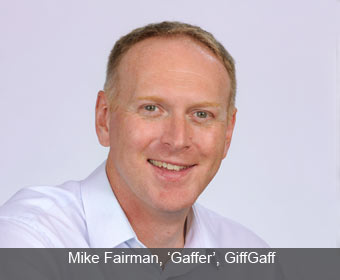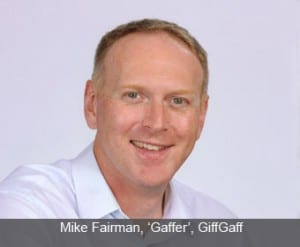Mike Fairman is the CEO—or ‘Gaffer’—of O2 UK subsidiary GiffGaff, a new MVNO that aims to harness the collective efforts of its customer base, and derive operational cost savings in the process. But is one man’s groundbreaking experiment into crowd sourcing another man’s gimmick?
November 25, 2009


mikefairman
Mike Fairman is the CEO—or ‘Gaffer’—of O2 UK subsidiary GiffGaff, a new MVNO that aims to harness the collective efforts of its customer base, and derive operational cost savings in the process. But is one man’s groundbreaking experiment into crowd sourcing another man’s gimmick?It was once thought that the birth of the virtual operator model would unleash a wave of MVNOs, in myriad hues. Any brand could launch one, any specific application or solution could form the central pillar of the offering, and numerous innovative business models could be proven by companies unburdened by the need for their own network infrastructure. The reality has proven somewhat different.
Some big consumer brands have made successes of MVNO operations, and some niche business models—in particular ethnic operations serving ex-patriot and migrant communities—have proven fruitful. But the most prominent legacy of the virtual operator in the mobile industry has been price erosion. That’s not necessarily a bad thing, but it wasn’t really the aim.
The MVNO model has encouraged a degree of experimentation, though, most notably with UK operation Blyk, which attempted to subsidise the airtime costs of its youth demographic with targeted mobile advertising campaigns. Blyk styled itself as a “youth media” rather than a telecoms operator, but was forced to alter its business model to provide services to other carriers when its advertising revenues proved insufficient.
Perhaps out of solidarity for a fellow experimentalist, Mike Fairman, CEO of new MVNO Giffgaff, argues that the Blyk model did not, in fact, fail. Rather, he says, it was a matter of timing; the economic downturn hit at a crucial stage for Blyk, and its advertisers reacted by pulling spend from unproven media.
Giffgaff is similar to Blyk in that it aims to attract subscribers with the promise of subsidised usage. In Giffgaff’s case, though, users are rewarded for working on behalf of the company itself; a form of crowd sourcing. Subscribers can earn airtime credits for bringing in new subscribers, for contributing to the firm’s marketing strategy and for responding to other subscribers’ customer service queries—something that was part of the Blyk operation as well.
Giffgaff is a subsidiary of Telefónica’s UK O2 operation, where Fairman previously held various roles, heading up online sales, launching the Home Broadband business and leading the new product development team. The inspiration for an MVNO built on crowd sourcing came, he says, “from things that are happening on the internet today.”
He goes on: “We were looking at things like Wikipedia, where people get together and do things for themselves and do a very good job—sometimes better than commercial organisations would do. There are also examples where companies are using customer input to help run the business and we were wondering why that wasn’t happening in the mobile market. That was the germ of the idea.”
That this wasn’t already happening in the mobile market means, of course, that the firm is heading into the unknown; its model is not proven in this industry. But, says Fairman, existing crowd source projects from other sectors—where often the customers are not rewarded at all—are proof enough for the management team at Giffgaff.
“If you look at acquisitions, then ‘member-get-member’ schemes have been used by a number of organisations very successfully. All we’re doing is using the internet with a bit of technology to make it work,” Fairman argues. “On the customer service side we’re putting emphasis on customer forums, using them as a way of initially building up the quality of our responses. If you look at the site for Trip Adviser, or the forums for the iPhone, the quality of responses is very good.
“That leaves the marketing an innovation ideas and, in the UK, there’s a very creative vibrant community. If you’ve got a base of customers you only need a small percentage of those to be interested in contributing ideas for you to get a good volume,” he says.
The point of these tactics is to slash operational costs for the MVNO. Customer service provision isn’t cheap, nor are marketing and customer acquisition. If its customers can shoulder these burdens, Giffgaff should be able to reward them and still come out ahead, Fairman says. “Twice a year, we’ll look at all the activity and contributions that people have made over the last six months and rank those customers,” he explains. “We’ll take the cash we’d normally spend on big ad campaigns and call centres and then the people at the top of the ranking will get the most money back.”
There will, he says, be opportunities for customers to earn back all of the money they spend, although the firm has yet to explore the possibility that some of its customers could be net-positive, like those individuals who install solar panels or wind turbines at their homes and sell energy back to the grid.
Compiling the ranking of customer contribution will, Fairman concedes, be a difficult task. It might be simple to keep abreast of a given customer’s performance in terms of member-get-member activity, but tracking their participation in forums, or the quality of responses they give to other customers’ service queries is going to be very tricky indeed. “We need to employ some fairly sophisticated technology in order to do that,” says Fairman, offering no further detail.
Customer service—for the customers at least—can be a thorny issue. At Giffgaff it will be online only, with the firm accepting no inbound telephone queries. Any issues that cannot reasonably be dealt with by the forums or over email will see the customer contacted over the phone by a Giffgaff support staff member. How many of these the firm has Fairman does not reveal, saying only that the number will grow with the customer base.
In line with other MVNOs looking at strict cost management strategies, Giffgaff will be a SIM-only operation. SIM-only offerings have been gaining traction over the last 18-months, aided by downturn-inspired deals that provide cut price airtime in return for customers keeping their own handset and not requiring the operator to subsidise an expensive new one. Nonetheless, subscribers in developed markets like the UK are more far more likely to change carrier for a new phone than for any other reason.
The exception to this rule is when the decision is purely cost based, and when the customer is prepared to accept a lower level of service for a cheaper bill. But, while Fairman promises that the firm’s pricing will be “competitive”, the Giffgaff proposition doesn’t seem to fit comfortably with the ‘no-frills’ tag. And although the MVNO is happy to have customers who do not get involved, the firm’s central premise requires a high level of sophistication and interaction from its customers.
So isn’t there a concern that consumers with that level of savvy will be more likely to be keen to own high-end handsets; more likely to be looking for a deal on a phone as much as on the airtime? Fairman believes not. “Certainly not. Not from the research we’ve done. All of the evidence suggests that there are lots of people out there who are happy to use an existing handset,” he says.
He also indicates that the firm is not targeting a standard demographic market segment; while the Giffgaff name and the firm’s existing branding may sound and look like a brand aiming for the youth market, for example, it is, he says, “more of a state of mind positioning”.
He continues: “This is for people who want to get involved with the brands that they use. The kind of people who write reviews on holiday sites, for example. There’s a broad spectrum of people who do that. The common factor among them is that they like sharing their views on things; they have the time and the inclination to do it.”
When Blyk first launched, it was dismissed in some quarters as a gimmick play and it will be a surprise if Giffgaff does not attract a certain amount of similar responses. On the firm’s website Fairman is billed not as the CEO but as the ‘Giffgaff Gaffer’, the kind of detail that could spur on the detractors. “I don’t think we’ll be seen as a gimmick at all,” says Fairman in response. “We’re just going out there with a good idea and something that we know from our research should have traction.”
In the initial stages of operation the firm will have to carry out its own marketing to get the ball rolling. O2 UK subscribers will not be disproportionately targeted, Fairman promises. “O2 believes there is a sizeable opportunity to exploit this,” he says. But we won’t be targeting O2 customers specifically. There will be some O2 customers in the marketing we do, but the majority will not be O2 users. We believe O2 will be better off as a result of this project, in net terms,” he says.
Giffgaff has announced no uptake targets, which will make judging its performance—from the outside at least—difficult. But simple customer numbers are not the only story for Giffgaff. It will have to judge its success both on the level of interaction that its customers embrace as well as the number of those customers. “A success for us is about having an involved customer base and a sizeable business to boot,” Fairman says.
Ultimately, of course, the project’s success will depend on the extent to which it is able to boost its margins by offloading operational costs onto its user base. In that light it is an operation that deserves to be closely watched by the wider carrier community.
Read more about:
DiscussionAbout the Author(s)
You May Also Like








.png?width=300&auto=webp&quality=80&disable=upscale)


_1.jpg?width=300&auto=webp&quality=80&disable=upscale)


.png?width=800&auto=webp&quality=80&disable=upscale)